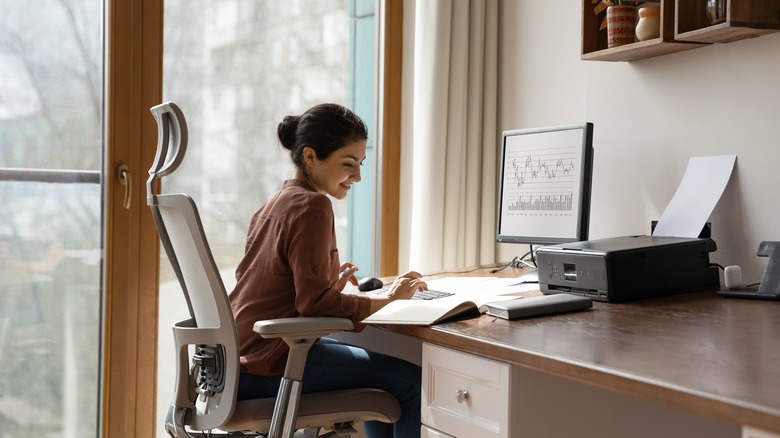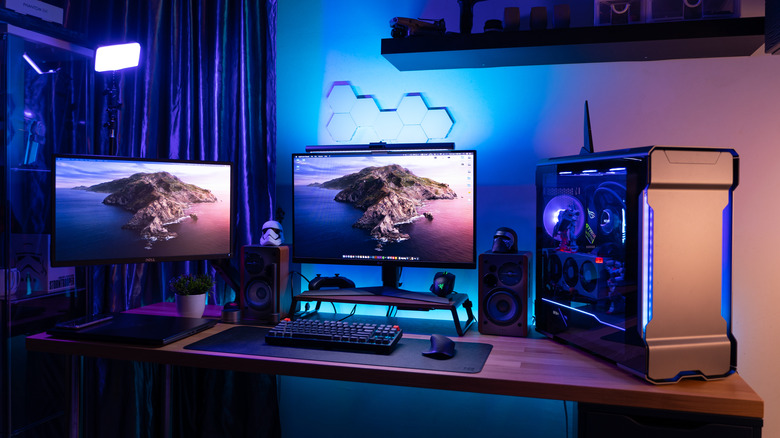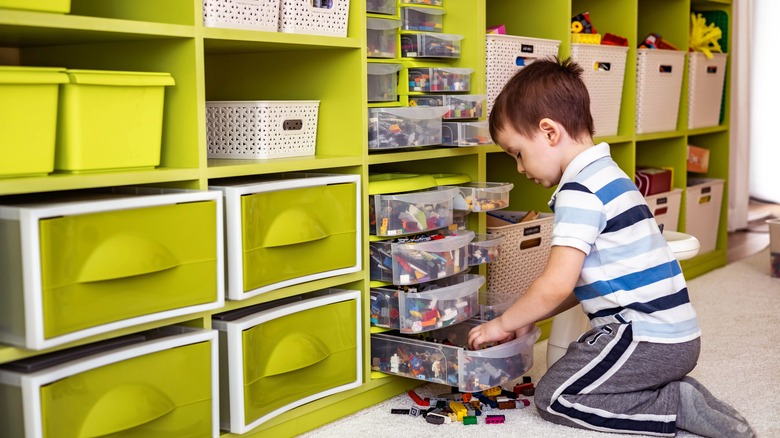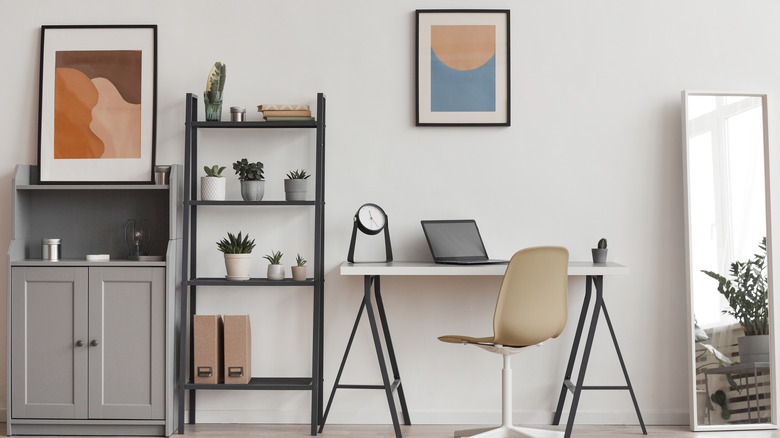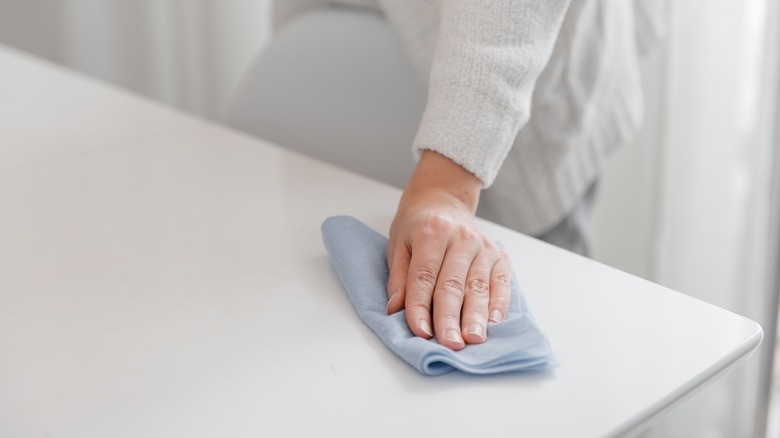Everything You Need To Know To Establish A Productive Office At Home
Home offices are becoming a standard feature in the modern house footprint. The coronavirus pandemic set off a wave of workplace transformations, with perhaps the most consequential being a transition to working from home that has persisted into the present, quasi-post-pandemic economic and social environment. While concern over transmission remains, the lockdown measures and intensity of focus on maintaining separation between individuals have largely passed. This environment sparked a need for employees to work from home rather than commuting to the office and potentially coming into contact with hundreds or even thousands of people along the way. But office managers and employees alike have found that working from home has inspired a new level of productivity and employee happiness, leading to an extension of these types of practices beyond a timeline of strict necessity.
Today, Pew Research Center reports that 59% of Americans who can work from home still do, while only 23% did so before the outbreak. One consequence of this change has been the transformation of the home from a place of relaxation to one that also supports work and many other requirements. Home life has become more versatile out of necessity, and it doesn't appear that Americans are looking to make a shift back to the way things were before anytime soon.
What this means is that permanent home offices are becoming a standard feature but crafting a productive and enjoyable environment can be difficult when facing off against the trappings of comfort that dominate the remainder of the home.
Start with your equipment
The first thing that any homeowner should do when working to incorporate a functional home office space in their property is an evaluation of the kinds of equipment that will be required to perform any sort of role necessary (consider browsing this list of essentials from The Balance). An accountant or stock trader might require multiple screens or even the addition of a television to keep news programs on in the background; artists might consider an additional drafting table or other dedicated creation medium.
When designing your home office or redesigning a space that you used as a temporary stopgap, it's important to think about the equipment that will be necessary to perform your job first. This will help you estimate the size of the room that you'll need and can go a long way to helping you design a productive layout that will support your daily duties.
A home office allows for a bit of experimentation or creativity when it comes to building a new layout. You might want to set your desk against the wall in order to add a secondary workspace or a bookshelf directly behind your primary installation. Alternatively, setting your desk so that you look directly out the window or positioning a window right next to your seat can give you increased airflow and natural lighting that can channel your energy into greater productive output.
But this all starts with the equipment that you require to do your job. It's simply impossible to set up a desk and integrated electronics without understanding what it is you'll be placing throughout the room. Many employees require at least a computer and printer setup. It's also likely that you'll need an extension cord and other peripheral equipment to make this space work for you.
Install a desk that provides ample workspace and motivation
Once you've established the kinds of electronics and other office essentials that will support your efforts, it's time to think about the desk in earnest. Many people setting up a home office make use of a simple tabletop desk, to begin with. However, you could purchase a desk that comes along with drawer space, storage equipment, and other integrated features that can amplify productivity and organization. Desks come in all shapes, colors, and sizes (via Habitat), and you can purchase a simple piece for $100 or less, or spend thousands on a luxury item that will go a long way to set the mood in this space.
The type of desk you purchase depends completely on your needs and personality. There really is no correct choice when it comes to the layout of your desk unit, however, one thing you should keep in mind is that desks come in all kinds of different area arrangements and certain layouts will work better for your needs than others. For instance, someone who does a lot of typing and writes notes on a pad or jots down information on a calendar might require a larger overall surface area for their desk. One option here is the use of an L-shaped desk or a V-shaped layout that provides equal area on either side of the bend. These desks certainly can be placed in the middle of a large room, but they work best when placed in the corner of a workspace in order to open up the room for other pieces of furniture, storage options, or even the use of a couch or any other type of seating installation.
Seating elements
The chair you sit in every day will play a huge role in your overall productivity. Selecting a chair that's comfortable and places your back and neck in a position conducive to solid workflow is an essential consideration to make. Office employees constantly complain about chronic back and neck problems, and this is due in large part to a hunched posture resulting from the use of less-than-ideal seating selections, according to Spine-Health. Many people take it upon themselves to purchase and install better equipment in their workplace as a result of this known issue. When setting up your own office at home, it's a good idea to think about your seating experience in the traditional office space that you've left behind. An ergonomic chair, wrist pad, and other posture-retaining implements can elevate the productivity and happiness that you experience in this newly established working area.
Another option that homeowners have when building out their home office space is the use of additional seating. A researcher for instance, might spend a significant amount of their time reading books or other documents. A couch or recliner can be a game changer when it comes to setting up the perfect office space that will see an extraordinary amount of reading and notetaking. Of course, in order to include these types of amenities you'll need to think about the overall space that you have to work with and the size requirements for your desk. An academic or writer might also be looking to incorporate one or more bookshelves in this office space, making the addition of a couch a little more difficult in some homes. There will always be a give and take when laying out the amenities of any room, but the chair and any other seating additions that you rely on to maintain productivity should be at the top of your priority list when establishing the footprint of your home office.
Focus on lighting elements
Lights play a significant role in anyone's ability to remain productive throughout the day. If your home office is dull and gray as a result of poor lighting, you're less likely to maintain the same level of energy and positivity throughout the course of the workday, let alone an entire week. Similarly, a home office that incorporates intensely clinical lighting will take away from the comfort level experienced in this space. Finding a happy medium with the use of bright but warming lights will make for an environment that allows you to work in an enjoyable and productive manner (viaWeWork).
It's also important to think about natural lighting. Men's Health suggests that even just 20 minutes spent outdoors in the sunshine and in nature can improve your mood and increase your physical well-being by a noticeable margin. The same kind of effect is true when bringing natural lighting into an interior space. A home that is lit with ample natural lighting is one that is immensely welcoming and comforting. In any workspace, it's crucial to balance illumination that will provide the ability to see and effectively work, but with a level of comfort that allows you to do these jobs in a low-stress (or ideally, a no-stress) environment. While your desk and chair will provide the physical structure to support your productivity, the lighting elements that make this space what it is are responsible for your mental attitude and productivity.
Consider your storage needs
Storage is another crucial element when building out an organized home office. There's always going to be a wide variety of needs when it comes to general storage. Employees across business sectors and brand names require the use of paper products and writing utensils, and they typically create and save a vast library of documents and notes surrounding any kind of business-wide output.
Everyone's storage needs will be unique to their own process and job role. For instance, a lawyer might need an army of file cabinets to support the storage and organization of significant volumes of individual case information and client data. Alternatively, someone performing a research role might need an ever-growing series of folders and storage bins to make sense of resources and notes taken on a wide variety of subjects and projects. Selecting a desk and supplemental storage solutions that fit your needs is all about introspection (via ExtraSpace).
You may also be looking to incorporate a home office space in a property that doesn't have ample free area available. An apartment with two bedrooms, for instance, may need to pull double or triple duty with the second room to support both storage needs of the homeowner, act as a guest bedroom, and function as the primary workspace for one or more of the property's residents.
Connectivity means many different things
After you've made your way through the physical aspects of the office, you'll need to think about certain connectivity solutions that will be required to get you and your workspace up to speed. For most, the issue of connectivity will revolve primarily around Wi-Fi or a hardline internet connection, but a secure network may be required as well (via bad). Ensuring that your internet connectivity is up to the standard that you require is a crucial task when making the transition from office to home workspace. The last thing you want to do is drop out of video conferences in the middle of staff meetings because your Wi-Fi box can't handle the increased pressure brought on by your daily tasks. Sorting out any internet connection problems that might slow down your workflow is an important step to take early on in the process of making this conversion.
Connectivity isn't just about your internet access though. A salesperson might require consistent phone service (a VoIP service is a must, via PC Mag), and certain professionals might even still use a fax to transmit documents. At the very least, you'll need to ensure that your equipment is up to standard when it comes to charging your cell phone and any peripheral devices that you use to take and place calls. Finally, in any work setting, it's possible that you'll utilize Bluetooth-connected devices such as a wireless keyboard and mouse, headphones, and other key assets that make your workday smoother. Ensuring that these devices are linked into your new space without issue and maintaining backup batteries and other resources to prevent outages from derailing your daily workflow will make for a highly productive space that rarely if ever feels the effects of distance.
Focus on vertical space for greater spatial efficiency
Vertical space additions are important when designing and outfitting a home office area. Many homeowners looking to define a separate workspace in their property will be using small rooms or newly built additions that might not incorporate a considerable amount of square footage. As such, it's important to get creative with your storage and spatial layout. For instance, you may require the consistent use of a few manuals or electronic equipment pieces. But these peripherals might not take up a continuous space on your desk throughout a typical day. Incorporating shelves next to or behind your primary work area can give you access to a storage solution that's within reach. Instead of placing these critical resources in drawers or a bookshelf behind you, vertical storage additions amplify the amount of usable space your desk can occupy (via Welp magazine).
As well, incorporating shelving units into your space makes the area feel more personalized and functional. By making this leap from a converted room to a dedicated work area, you are signaling to your most basic instincts that this is a place of productivity and professionalism. It's important to take your workspace seriously just like you prioritize your daily work. Adding in these types of efficiency-boosting features can make for a more welcoming space that sets you up for success on a daily basis while also giving you easier access to the resources that you require to perform at a high level.
Incorporate personalization and decoration to enhance your mood
The ambiance of your work area is such a crucial aspect of any question surrounding productivity and efficiency (via Kemmy D). You'll want to personalize any place that you call your workspace, whether it's at your own home or in an office setting. It's even more important to create personalization and decorative stylings in a homework environment though. Tailoring this space to your own unique tastes will make it feel like a professional environment but also add a sense of comfort. In your office, you may only have a picture of loved ones, some kind of decoration that a child made, or something that you collected while traveling. However, if you maintain a spartan work environment at home then you can fall into the trap of feeling disconnected from both family and your coworkers. A home office that lacks personalization is one that feels utterly incomplete. There's absolutely no excuse for not decorating, and that feeling of disconnect becomes palpable in just a short space of time. Personalization is crucial in any work environment and when building a home workspace, you enjoy even greater freedom to make this place whatever you wish.
Personalization can be something as simple as painting the walls in a color that enhances your mood or with a shade that you just really like. Color psychology is a powerful thing, and it can be used to great effect in your workspace and in any other part of the home as well (via Verywell Mind). Similarly, incorporating decorations that showcase your personality and hobbies can give you a tangible representation of the things that you will earn through your hard work every day. A scuba diver, for instance, might incorporate pictures of the sea or underwater snapshots taken either by professionals or personally. Looking at these images will remind you of all the things that you are work enables you to do during your off time.
Cordon off your workspace from the relaxing home areas beyond it
It's important to separate your work environment from your relaxation space. A home office that doesn't successfully cordon off these two separate phases of home life is one that may blur the lines between work and play. Those who work from home have seen an uptick in general happiness: They're 22% happier with their jobs, reports The London Mother. However, if you don't carefully protect your time then it's easy to fall into a cycle of overworking. Because there is no commute to separate your workday and time at home (via Business Insider), it can be enticing to spend just that extra hour working on some project to get ahead of the curve. It's crucial to maintain a healthy work-life balance, but working from home, while introducing many positive aspects, can skew this balance away from time spent outside of the office.
Physically sectioning off a workspace from other areas of your property is a good way to enshrine this divide between work and home time, as noted by The Muse. But this may not be possible for everyone. Regardless of where your office sits in the overall layout of your home, it's crucially important to dedicate specific hours of the day to both work and relaxation. Maintaining a firm schedule for your daily activities can help you effectively manage this divide and enjoy all the benefits of your home office without also having to weather the many potential negatives and pressures that come along with this arrangement.
Engage in routine cleaning and tidying efforts to maintain productivity and focus
Finally, after you've established your home office, it's important to maintain a diligent cleaning routine. In a traditional office setting, most employers or building management teams will employ routine cleaning services to maintain tidiness and productivity for the people who call the office their own (via Zippia). A clean office is one that allows you to settle in with your thoughts and focus on the tasks at hand. Conversely, an office in need of a deep clean or simple tidy is one that can distract your focus and take away from your ability to do your job effectively, according to Corporate Suites.
In today's world, efficiency is one of the crucial metrics by which employees are judged. This means that distracted employees are often ones that also deal with excessive external sources of stress. This can become a vicious cycle in which an untidy desk leads to a drop in productivity which induces a stress response, furthering this lack of production to an even greater extent.
Maintaining cleanliness in your office space becomes solely your responsibility when establishing a working space in your own residence. Spending five to ten minutes a day (or perhaps every other day) will make for a clean and organized environment that allows you to focus on the tasks at hand rather than the clutter around you.
